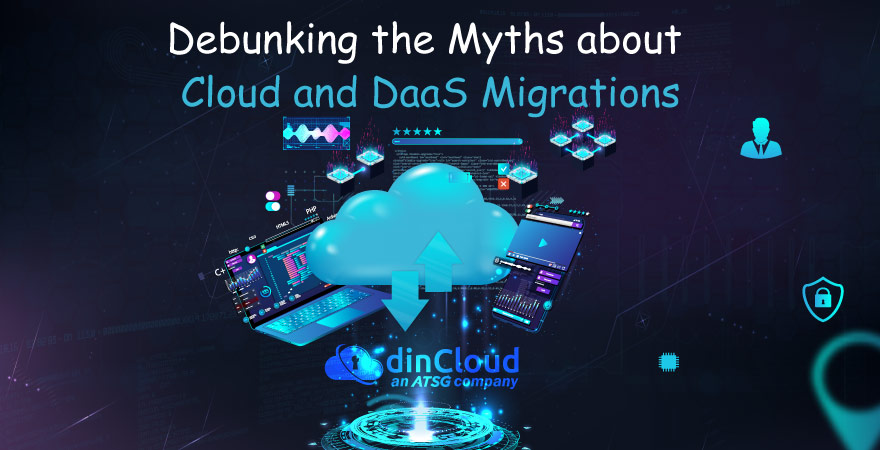Cloud Computing has attained an instrumental role in enterprise operations. This has not been a quick change, as migration to the Cloud is something that does not just happen overnight. Cloud Computing has achieved this status on the back of sheer merit.
The flexibility, scalability and agility that modern enterprises crave today is not something they can achieve by relying upon legacy IT infrastructures. Take the example of on-premise Virtual Desktop Infrastructure (VDI).
Granted VDI gives enterprises some degree of flexibility, but the accompanying challenges can also prove overwhelming for enterprises. There may also be cases where the whole value proposition of VDI is neutralized by roadblocks and implementation bottlenecks.

Related: Harvard Business Review Traces the Cloud Journey of Enterprises
The Value Proposition of Cloud and DaaS
According to a recent study by management consultancy firm McKinsey & Company, enterprises that embrace Cloud Computing stand to unlock nearly US $1 Trillion in terms of the cumulative value they can generate.
Forrester Consulting also released similar statistics in its Total Economic Impact (TEI) Study, about the value proposition hidden in Cloud Computing and Desktop as a Service (DaaS) solutions, here’s how.
On average, the enterprise which gives up its on-premise VDI deployment in favor of cloud based DaaS, can experience financial gains to the tune of US $6.7 Million, as opposed to the estimated costs of US $2.7 Million it would incur on VDI.
If we crunch these numbers, this translates into a Net Present Value (NPV) of US $4.05 Million, spread over a period of three years. This converts into a Return on Investment (ROI) of 153%, which is phenomenal on many counts.
Related: How Desktop as a Service (DaaS) Streamlines Hybrid Work?
Debunking the Myths about Cloud and DaaS Migrations
If the numbers we have crunched above are so good, then what are the factors that still make top IT leaders hesitant to migrate towards Cloud Computing and DaaS solutions? This post is all about those factors, and we will be debunking these myths as well.
The Migration Will be Complicated
Granted any migration to the Cloud or DaaS will accompany the element of change. This by no means implies that the process will also be equally complicated. It has been observed that most complications that arise during migrations are the result of poor planning.
Related: Why & How are Enterprises Moving towards Green IT in 2022?
I Will End Up Paying More
This is a major myth about Cloud infrastructures and DaaS solutions, which is mainly the result of a lack of awareness. With a move to DaaS, you are in fact moving away from a Capital Expenditure (CapEx) towards an Operating Expense (OpEx) model.
Leading Cloud and DaaS providers like dinCloud take all the guesswork about your Cloud or DaaS costs out of the equation. This is made possible with our Flat Rate Pricing Model, which ensures you not only save big on costs, but you also know these costs beforehand.
Related: The Transformation of Healthcare with Cloud Computing, AI and IoT
Additional Hardware and Human Resources Required
Instead of increasing your IT hardware and related human resources, DaaS solutions tend to reduce both. You can gradually scale down your on-premise IT resources, as all the data and heavy lifting is done by state of the art data centers of the DaaS provider like dinCloud.
With a reduced IT hardware footprint, and much streamlined IT operations, you no longer need a large in-house IT team. The cloud infrastructure, its maintenance, patching and update etc. are all looked after by the Cloud Service Provider (CSP) like dinCloud.
Related: Why are Small Businesses Investing Heavily in the Public Cloud?
Now that we have debunked the major myths about Cloud Computing and DaaS solutions, let us conclude this post with a few useful pointers along this transition phase.
- Preparing an elaborate cloud migration strategy is very important, duly taking into account the business model and the possible constraints.
- Active involvement and ownership of the top management, along every step of the migration phase.
- To minimize roadblocks, disruptions and downtimes, your transition should be in phases, and the on-premise infrastructure should be there to support if needed.
- Duly incorporating the element of costs is very important, so the process does not face any budgetary constraints or overruns.
- Working with a trust worthy Cloud and DaaS partner, like dinCloud, which not only has rich industry experience on its back, but also takes you along every step.
Conclusion
Moving to Cloud Computing and DaaS is no more a question of if, rather it is more a matter of when. The answer to this question is that with the right set of tools, proper planning, and the right DaaS provider, cloud migrations can meet unrivaled benefits.
Contact dinCloud, an ATSG company, for top notch, enterprise grade Cloud Computing and Desktop as a Service (DaaS) solutions which are secure, flexible and scalable on the fly.


